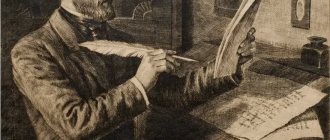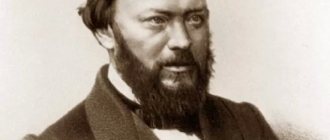History of the play
The analysis of “The Thunderstorm” should begin with the history of its writing, because the circumstances of that time played an important role in the creation of the plot. The play was written in 1859 during Ostrovsky's travels around the Volga region. The writer observed and explored not only the beauty of nature and the sights of the Volga region cities.
He was no less interested in the people he met on his journey. He studied their characters, everyday life, and their life stories. Alexander Nikolaevich took notes, and then based on them he created his work.
But the story of the creation of Ostrovsky’s “Thunderstorm” has different versions. For a very long time they were of the opinion that the writer took the plot for the play from real life. There lived a girl in Kostroma who, unable to withstand her mother-in-law’s oppression, threw herself into the river.
Researchers found many matches. This happened in the same year in which the play was written. Both girls were young and were married off at a very early age. Both were oppressed by their mothers-in-law, and their husbands were weak-willed. Katerina had an affair with the nephew of the most influential man in the city, and a poor Kostroma girl had an affair with a postal employee. It is not surprising that due to such a large number of coincidences, for a long time everyone believed that the plot was based on real events.
But more detailed studies have refuted this theory. Ostrovsky sent the play to print in October, and the girl dropped out a month later. Therefore, the plot could not be based on the life story of this Kostroma family. However, perhaps, thanks to his powers of observation, Alexander Nikolaevich was able to predict this sad end. But the story of the creation of the play also has a more romantic version.
“The Thunderstorm” - the history of the creation of Ostrovsky’s play - briefly about the time the drama was written
“The Thunderstorm” was not written by Ostrovsky... “The Thunderstorm” was written by Volga. S. A. Yuryev
Alexander Nikolaevich Ostrovsky was one of the largest cultural figures of the 19th century. His work will forever remain in the history of literature, and his contribution to the development of Russian theater is difficult to overestimate. The writer made some changes to the production of plays: attention should no longer be focused on just one character; a fourth scene is introduced, separating the audience from the actors in order to emphasize the conventionality of what is happening; ordinary people and standard everyday situations are depicted. The last position most accurately reflected the essence of the realistic method that Ostrovsky adhered to. His literary work began in the mid-1840s. “Our people are numbered,” “Family pictures,” “Poverty is not a vice” and other plays were written. The drama “The Thunderstorm” has a history of creation that is not limited to just working on the text and writing conversations between the characters.
The history of the creation of the play “The Thunderstorm” by Ostrovsky begins in the summer of 1859, and ends a few months later, in early October. It is known that this was preceded by a trip along the Volga. Under the patronage of the Maritime Ministry, an ethnographic expedition was organized to study the customs and morals of the indigenous population of Russia. Ostrovsky also took part in it.
The prototypes of the city of Kalinov were many Volga towns, at the same time similar to each other, but with something unique: Tver, Torzhok, Ostashkovo and many others. Ostrovsky, as an experienced researcher, recorded all his observations about the life of the Russian province and the characters of the people in his diary. Based on these recordings, the characters of "The Thunderstorm" were later created.
For a long time there was a hypothesis that the plot of “The Thunderstorm” was completely borrowed from real life. In 1859, precisely at this time the play was written, a resident of Kostroma left home early in the morning, and later her body was discovered in the Volga. The victim was the girl Alexandra Klykova. During the investigation, it became clear that the situation in the Klykov family was quite tense. The mother-in-law constantly mocked the girl, and the spineless husband could not influence the situation. The catalyst for this outcome of events was the love relationship between Alexandra and the postal employee.
This assumption is deeply ingrained in people's minds. Surely in the modern world, tourist routes would already be laid in that place. In Kostroma, “The Thunderstorm” was published as a separate book; during the production, the actors tried to resemble the Klykovs, and local residents even showed the place from which Alexandra-Katerina allegedly threw herself. Kostroma local historian Vinogradov, to whom the famous literature researcher S. Yu. Lebedev refers, found many literal coincidences in the text of the play and in the “Kostroma case”. Both Alexandra and Katerina were married off early. Alexandra was barely 16 years old. Katerina was 19.
Both girls had to endure discontent and despotism from their mothers-in-law. Alexandra Klykova had to do all the menial housework. Neither the Klykov family nor the Kabanov family had children. The series of “coincidences” does not end there. The investigation knew that Alexandra had a relationship with another person, a postal worker. In the play "The Thunderstorm" Katerina falls in love with Boris. That is why for a long time it was believed that “The Thunderstorm” was nothing more than a real-life incident reflected in the play.
However, at the beginning of the twentieth century, the myth created around this incident was dispelled due to a comparison of dates. So, the incident in Kostroma occurred in November, and a month earlier, on October 14, Ostrovsky took the play to print. Thus, the writer could not display on the pages what had not yet happened in reality. But this does not make the creative history of “Groza” any less interesting. It can be assumed that Ostrovsky, being an intelligent person, was able to predict how the girl’s fate would turn out in the typical conditions of that time. It is quite possible that Alexandra, like Katerina, was tormented by the stuffiness that is mentioned in the play. The old orders are becoming obsolete and the absolute inertia and hopelessness of the current situation. However, one should not completely correlate Alexandra with Katerina. It is quite possible that in the case of Klykova, the reasons for the girl’s death were only everyday difficulties, and not a deep-seated personal conflict, like Katerina Kabanova’s.
The most realistic prototype of Katerina can be called theater actress Lyubov Pavlovna Kositskaya, who later played this role. Ostrovsky, like Kositskaya, had his own family; it was this circumstance that prevented the further development of the relationship between the playwright and the actress. Kositskaya was originally from the Volga region, but at the age of 16 she ran away from home in search of a better life. Katerina’s dream, according to Ostrovsky’s biographers, was nothing more than the recorded dream of Lyubov Kositskaya. In addition, Lyubov Kositskaya was extremely sensitive to faith and churches. In one of the episodes, Katerina utters the following words:
“... Until death, I loved going to church! Exactly, it happened that I would enter heaven, and I didn’t see anyone, and I didn’t remember the time, and I didn’t hear when the service was over... And you know, on a sunny day such a light pillar comes from the dome, and smoke moves in this pillar, like clouds, and I see that it used to be as if angels were flying and singing in this pillar.”
The history of the creation of Ostrovsky's play "The Thunderstorm" is interesting in its own way: there are both legends and personal drama. The premiere of “The Thunderstorm” took place on November 16, 1859 on the stage of the Maly Theater.
Previous
EssaysThe role of landscape in the poem by Mtsyri Lermontov - facts for an essay on the topic
Next
WorksGenre of Ostrovsky’s “Thunderstorms” - what is the definition of the genre of this play
Who was the prototype for the main character?
In the analysis of “The Thunderstorm,” one can also point out that there were many disputes about who the image of Katerina was copied from. There was also room for the writer’s personal drama. Both Alexander Nikolaevich and Lyubov Pavlovna Kositskaya had families. And this served as an obstacle to the further development of their relationship.
Kositskaya was a theater actress, and many believe that she is the prototype of the image of Katerina in Ostrovsky’s “The Thunderstorm.” Later, Lyubov Pavlovna will play her role. The woman herself was from the Volga region, and the playwright’s biographers wrote that “Katerina’s Dream” was written down from Kositskaya’s words. Lyubov Kositskaya, like Katerina, was a believer and loved the church very much.
But “The Thunderstorm” is not only a drama about personal relationships, it is a play about the growing conflict in society. In that era there were already people who wanted to change the old order, but the ossified “Domostroevsky” society did not want to obey them. And this confrontation is reflected in Ostrovsky’s play.
Controversy over the origins of the plot
Statements regarding the prototypes and plot basis of the work are very contradictory. Thus, for Kostroma residents, the creative history of the creation of the play “The Thunderstorm” was directly related to recent tragic incidents in their city. Some details indicated that the prototype of Katerina could be an acquaintance of the writer L.P. Kositskaya. People who personally knew the playwright believed that the appearance of “The Thunderstorm” was the result of Ostrovsky’s journey along the Volga.
What prompted such judgments?
Summary of Ostrovsky's "Thunderstorm"
The play takes place in the fictional Volga city of Kalinov. The inhabitants of this town are people accustomed to deception, tyranny, and ignorance. Several people from the Kalinovsky society stood out for their desire for a better life - these are Katerina Kabanova, Boris and Kuligin.
The young girl was married to the weak-willed Tikhon, whose stern and oppressive mother constantly oppressed the girl. Kabanikha established very strict rules in her house, so all members of the Kabanov family did not like her and were afraid of her. During Tikhon's departure on business, Katerina secretly meets with Boris, an educated young man who came from another city to visit his uncle, Dikiy, a man of the same tough character as Kabanikha.
When her husband returned, the young woman stopped seeing Boris. She feared punishment for her action because she was pious. Despite all the persuasion, Katerina confessed everything to Tikhon and his mother. The boar began to tyrannize the young woman even more. Boris's uncle sent him to Siberia. Katerina, having said goodbye to him, rushed into the Volga, realizing that she could no longer live in tyranny. Tikhon accused his mother that it was because of her attitude that his wife decided to take such a step. This is a summary of Ostrovsky's "The Thunderstorm".
Chronology of work on the drama
The history of the creation of the play “The Thunderstorm” raises many questions. Briefly it can be described as follows.
Ostrovsky most likely began work on the work in July 1859 (in any case, no later than this month), and in early October he sent the finished text to the publishing house. This is proven by the original manuscript, which is still kept in the Russian State Library. A month later, the play was already staged on the St. Petersburg stage: on November 16 there was a premiere at the Maly Theater, on December 2 at the Alexandrinsky Theater. The following year it was published in the “Library for Reading” (in No. 1), and a little later it was published as a separate book.
Brief description of the characters
The next point in the analysis of the play is the characteristics of the heroes of Ostrovsky’s “The Thunderstorm”. All the characters turned out to be memorable, with bright characters. The main character (Katerina) is a young woman brought up in the house-building order. But she understood the rigidity of these views and strived for a better life, where all people would live honestly and do the right thing. She was devout and loved to go to church and pray.
Kabanova Marfa Ignatievna is a widow, a wealthy merchant. She adhered to the principles of house building. She had a bad temper and established tyrannical rules in the house. Tikhon, her son, a weak-willed man, loved to drink. He understood that his mother was unfair to his wife, but was afraid to go against her will.
Boris, an educated young man, came so that Dikoy would give him part of the inheritance. He is impressionable and does not accept the laws of Kalinov society. Dikoy is an influential man, everyone was afraid of him because they knew what a harsh character he had. Kuligin is a tradesman who believes in the power of science. Tries to prove to others the importance of scientific discoveries.
This is a characteristic of the heroes of Ostrovsky’s “The Thunderstorm”, who played a significant role in the plot. They can be divided into two small societies: those who held the old views and those who believed that change was necessary to create better conditions.
The history of the creation of Ostrovsky's "Thunderstorm"
I. S. Turgenev spoke very positively about this work, emphasizing the enormous writing talent of A. N. Ostrovsky with particular trepidation and delight. The history of the creation of Ostrovsky’s “Thunderstorm” dates back to the socio-political situation in the country in the fifties and sixties of the 19th century. It was a turning point in history and social thought. During that period, more and more accusatory literature began to appear, and the work of A.N. Ostrovsky had to do it on time. Topics that were popular at that time and caused significant controversy: serfdom, the position of women in society and the intelligentsia of various ranks. A.N. Ostrovsky in “The Thunderstorm” raises an equally relevant topic - domestic tyranny, the domination of money over the life and meaning of a person.
The year the drama was written is considered to be 1859, at which time the first productions of the play appeared in the best theaters in Moscow and St. Petersburg. The work appeared in print a year later (1860). The history of the creation of Ostrovsky's "Thunderstorm" shows that the work most fully reflected the socio-political thought of that time.
Ray of light in the play
In the analysis of "The Thunderstorm" it is worth highlighting the main female character - Katerina Kabanova. It is a reflection of what tyranny and despotic attitudes can do to a person. The young woman, although she grew up in the “old” society, unlike the majority, sees the injustice of such orders. But Katerina was honest, she did not want and did not know how to deceive, and this is one of the reasons why she told her husband everything. And those people who surrounded her were accustomed to deceiving, fearing, and tyrannizing. But the young woman could not accept this; all her spiritual purity opposed it. Because of the inner light and the desire to live honestly, the image of Katerina from Ostrovsky’s “The Thunderstorm” was compared to “a ray of light in a dark kingdom.”
And the only joys in her life were prayer and love for Boris. Unlike all those who talked about faith, Katerina believed in the power of prayer, she was very afraid of committing a sin, so she could not meet with Boris. The young woman understood that after her act, her mother-in-law would torment her even more. Katerina saw that in this society no one wanted to change, and she could not live among injustice, misunderstanding and without love. Therefore, throwing herself into the river seemed to her the only way out. As Kuligin later said, she found peace.
Image of a thunderstorm
In the play, some of the important episodes are associated with a thunderstorm. According to the plot, Katerina was very afraid of this natural phenomenon. Because people believed that a thunderstorm would punish a sinful person. And all these clouds, thunder - all this only intensified the depressing atmosphere of the Kabanovs’ house.
In the analysis of “The Thunderstorm,” it should also be noted that it is very symbolic that all episodes with this natural phenomenon are connected with Katerina. This is a reflection of her inner world, the tension in which she was, the storm of feelings that raged inside her. Katerina was afraid of this intensity of feelings, so she was very worried when there was a thunderstorm. Also, thunder and rain are a symbol of purification; when the young woman threw herself into the river, she found peace. Just like nature seems cleaner after rain.
Is the thunderstorm a personal drama of A.N. Ostrovsky?
Another version, concerning the prototype of the main character, is associated with the playwright’s own note in the text. Next to Katerina’s monologue, in which she tells Varenka about her dream, it is written: “I heard from L.P. about the same dream..." For L.P. the famous actress L.P. Kositskaya, who most likely had a relationship with Ostrovsky, is hiding. Both are family people, so they are forced to hide their affection. Researchers explaining the creation of Ostrovsky’s play “The Thunderstorm” and considering this version also refer to the fact that it was Kositskaya who played the role of the main character for the first time. And the playwright, as you know, preferred to choose actors himself to stage his own works at the Maly Theater.
The main idea of the play
What is the main meaning of Ostrovsky's "Thunderstorm"? The playwright sought to show how unfair society is structured. How they can oppress the weak and defenseless, leaving people no choice. Perhaps Alexander Nikolaevich wanted to show that society should reconsider its views. The meaning of Ostrovsky's "The Thunderstorm" is that one cannot live in ignorance, lies and rigidity. We must strive to become better, to treat people more tolerantly, so that their life does not resemble the “dark kingdom”, like Katerina Kabanova’s.
Personality conflict
The play shows the growth of Katerina's internal conflict. On the one hand - the understanding that it is impossible to live in tyranny, love for Boris. On the other hand, strict upbringing, a sense of duty and fear of committing a sin. A woman cannot come to one decision. Throughout the play, she meets with Boris, but does not even think about leaving her husband.
The conflict is growing, and the impetus for Katerina’s sad death was separation from Boris and increased persecution from her mother-in-law. But personal conflict does not occupy the most important place in the play.






